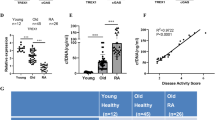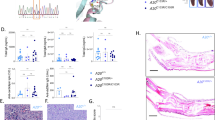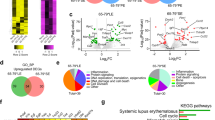Abstract
Mice selected for the maximum acute inflammatory reaction (AIRmax) are highly susceptible to pristane-induced arthritis (PIA), whereas mice selected for the minimum response (AIRmin) are resistant. These lines show distinct patterns of leukocyte infiltration and R and S allele frequency disequilibrium of the solute carrier family 11a member 1 (Slc11a1) gene. In order to study the interactions of the Slc11a1 R and S alleles with the inflammation modulating Quantitative Trait Loci (QTL) during PIA development, homozygous AIRmaxRR, AIRmaxSS, AIRminRR and AIRminSS lines were produced by genotype-assisted breedings. These mice received two intraperitoneal injections of 0.5 ml pristane at 60-day intervals, and the subsequent development of arthritis was assessed for 210 days. Cytokine-secreting cell profiles were investigated using enzyme-linked immunospot. Arthritis incidence in AIRmaxRR mice reached 29%, whereas PIA incidence in AIRmaxSS mice was 70% by day 180. AIRminRR mice were resistant, whereas 13.3% of AIRminSS mice became arthritic. The presence of the defective S allele also increased arthritis severity, although acute inflammation was higher in mice bearing the R allele. A predominant Th0/Th2-type response in Slc11a1SS mice was observed. These results indicate that Slc11a1 is a strong candidate for the QTL modulating acute inflammation and for PIA.
This is a preview of subscription content, access via your institution
Access options
Subscribe to this journal
Receive 6 digital issues and online access to articles
$119.00 per year
only $19.83 per issue
Buy this article
- Purchase on Springer Link
- Instant access to full article PDF
Prices may be subject to local taxes which are calculated during checkout





Similar content being viewed by others
References
Silman AJ, Pearson JE . Epidemiology and genetics of rheumatoid arthritis. Arthritis Res 2002; 4 (Suppl 3): S265–S272.
Runstadler JA, Saila H, Savolainen A, Leirisalo-Repo M, Aho K, Tuomiehto-Wolf E et al. Association of SLC11A1(NRAMP1) with persistent oligoarticular and polyarticular rheumatoid factor-negative juvenile idiopathic arthritis in Finnish patients: haplotype analysis in Finnish families. Arthritis Rheum 2005; 52: 247–256.
Rodriguez MR, Gonzalez-Escribano MF, Aguilar F, Valenzuela A, Garcia A, Nunez-Roldan A . Association of NRAMP1 promoter gene polymorphism with the susceptibility and radiological severity of rheumatoid arthritis. Tissue Antigens 2002; 59: 311–315.
Singal DP, Li J, Zhu Y, Zhang G . NRAMP1 gene polymorphisms in patients with rheumatoid arthritis. Tissue Antigens 2000; 55: 44–47.
Kannan K, Ortmann RA, Kimpel D . Animal models of rheumatoid arthritis and their relevance to human disease. Pathophysiology 2005; 12: 167–181.
Potter M, Wax JS . Genetics of susceptibility to pristane-induced plasmacytomas in BALB/cAn: reduced susceptibility in BALB/cJ with a brief description of pristane-induced arthritis. J Immunol 1981; 127: 1591–1595.
Thompson SJ, Thompson HS, Harper N, Day MJ, Coad AJ, Elson CJ et al. Prevention of pristane-induced arthritis by the oral administration of type II collagen. Immunology 1993; 79: 152–157.
Stasiuk LM, Ghoraishian M, Elson CJ, Thompson SJ . Pristane-induced arthritis is CD4+ T-cell dependent. Immunology 1997; 90: 81–86.
Thompson SJ, Hitsumoto Y, Zhang YW, Rook GA, Elson CJ . Agalactosyl IgG in pristane-induced arthritis. Pregnancy affects the incidence and severity of arthritis and the glycosylation status of IgG. Clin Exp Immunol 1992; 89: 434–438.
Thompson SJ, Rook GA, Brealey RJ, van der ZR, Elson CJ . Autoimmune reactions to heat-shock proteins in pristane-induced arthritis. Eur J Immunol 1990; 20: 2479–2484.
Thompson SJ, Francis JN, Siew LK, Webb GR, Jenner PJ, Colston MJ et al. An immunodominant epitope from mycobacterial 65-kDa heat shock protein protects against pristane-induced arthritis. J Immunol 1998; 160: 4628–4634.
Thompson SJ, Elson CJ . Susceptibility to pristane-induced arthritis is altered with changes in bowel flora. Immunol Lett 1993; 36: 227–231.
Ibanez OM, Stiffel C, Ribeiro OG, Cabrera WK, Massa S, De Franco M et al. Genetics of nonspecific immunity: I. Bidirectional selective breeding of lines of mice endowed with maximal or minimal inflammatory responsiveness. Eur J Immunol 1992; 22: 2555–2563.
Vigar ND, Cabrera WH, Araujo LM, Ribeiro OG, Ogata TR, Siqueira M et al. Pristane-induced arthritis in mice selected for maximal or minimal acute inflammatory reaction. Eur J Immunol 2000; 30: 431–437.
Wooley PH, Sud S, Whalen JD, Nasser S . Pristane-induced arthritis in mice. V. Susceptibility to pristane-induced arthritis is determined by the genetic regulation of the T cell repertoire. Arthritis Rheum 1998; 41: 2022–2031.
Shaw MA, Clayton D, Blackwell JM . Analysis of the candidate gene NRAMP1 in the first 61 ARC National Repository families for rheumatoid arthritis. J Rheumatol 1997; 24: 212–214.
Canonne-Hergaux F, Gruenheid S, Govoni G, Gros P . The Nramp1 protein and its role in resistance to infection and macrophage function. Proc Assoc Am Physicians 1999; 111: 283–289.
Fritsche G, Dlaska M, Barton H, Theurl I, Garimorth K, Weiss G . Nramp1 functionality increases inducible nitric oxide synthase transcription via stimulation of IFN regulatory factor 1 expression. J Immunol 2003; 171: 1994–1998.
Lalmanach AC, Montagne A, Menanteau P, Lantier F . Effect of the mouse Nramp1 genotype on the expression of IFN-gamma gene in early response to Salmonella infection. Microbes Infect 2001; 3: 639–644.
Wojciechowski W, DeSanctis J, Skamene E, Radzioch D . Attenuation of MHC class II expression in macrophages infected with Mycobacterium bovis bacillus Calmette-Guerin involves class II transactivator and depends on the Nramp1 gene. J Immunol 1999; 163: 2688–2696.
Fortier A, Min-Oo G, Forbes J, Lam-Yuk-Tseung S, Gros P . Single gene effects in mouse models of host: pathogen interactions. J Leukoc Biol 2005; 77: 868–877.
Govoni G, Vidal S, Gauthier S, Skamene E, Malo D, Gros P . The Bcg/Ity/Lsh locus: genetic transfer of resistance to infections in C57BL/6J mice transgenic for the Nramp1 Gly169 allele. Infect Immun 1996; 64: 2923–2929.
Zaharik ML, Cullen VL, Fung AM, Libby SJ, Kujat Cloy SL, Coburn B et al. The Salmonella enterica serovar Typhimurium divalent cation transport systems MntH and SitABCD are essential for virulence in an Nramp1G169 murine typhoid model. Infect Immun 2004; 72: 5522–5525.
Araujo LM, Ribeiro OG, Siqueira M, De Franco M, Starobinas N, Massa S et al. Innate resistance to infection by intracellular bacterial pathogens differs in mice selected for maximal or minimal acute inflammatory response. Eur J Immunol 1998; 28: 2913–2920.
Chia R, Achilli F, Festing MF, Fisher EM . The origins and uses of mouse outbred stocks. Nat Genet 2005; 37: 1181–1186.
Biozzi G, Ribeiro OG, Saran A, Araujo LM, Maria D, De Franco M et al. Effect of genetic modification of acute inflammatory responsiveness on tumorigenesis in the mouse. Carcinogenesis 1998; 19: 337–346.
Jensen JR, Peters LC, Borrego A, Ribeiro OG, Cabrera WK, Starobinas N et al. Involvement of antibody production quantitative trait loci in the susceptibility to pristane-induced arthritis in the mouse. Genes Immun 2006; 7: 44–50.
Roper RJ, Weis JJ, McCracken BA, Green CB, Ma Y, Weber KS et al. Genetic control of susceptibility to experimental Lyme arthritis is polygenic and exhibits consistent linkage to multiple loci on chromosome 5 in four independent mouse crosses. Genes Immun 2001; 2: 388–397.
Glant TT, Adarichev VA, Nesterovitch AB, Szarto S, Oswald JP, Jacobs JJ et al. Disease-associated qualitative and quantitative trait loci in proteoglycan-induced arthritis and collagen-induced arthritis. Am J Med Sci 2004; 327: 188–195.
Adarichev VA, Valdez JC, Bardos T, Finnegan A, Mikecz K, Glant TT . Combined autoimmune models of arthritis reveal shared and independent qualitative (binary) and quantitative trait loci. J Immunol 2003; 170: 2283–2292.
Adarichev VA, Vermes C, Hanyecz A, Mikecz K, Bremer EG, Glant TT . Gene expression profiling in murine autoimmune arthritis during the initiation and progression of joint inflammation. Arthritis Res Ther 2005; 7: R196–R207.
Goldring MB . The role of cytokines as inflammatory mediators in osteoarthritis: lessons from animal models. Connect Tissue Res 1999; 40: 1–11.
Santos-Junior RR, Sartori A, De Franco M, Ribeiro OG, Coelho-Castelo AA, Bonato V et al. Immunomodulation and protection induced by DNA-hsp65 vaccination in an animal model of arthritis. Hum Gene Ther 2005; 16: 1338–1345.
Beech JT, Siew LK, Ghoraishian M, Stasiuk LM, Elson CJ, Thompson SJ . CD4+ Th2 cells specific for mycobacterial 65-kilodalton heat shock protein protect against pristane-induced arthritis. J Immunol 1997; 159: 3692–3697.
De Franco M, Gille-Perramant MF, Mevel JC, Couderc J . T helper subset involvement in two high antibody responder lines of mice (Biozzi mice): HI (susceptible) and HII (resistant) to collagen-induced arthritis. Eur J Immunol 1995; 25: 132–136.
Soo SS, Villarreal-Ramos B, Khan CMA, Hormaeche CE, Blackwell J . Genetic control of immune response to recombinant antigens carried by an attenuated Salmonella typhimurium vaccine strain: Nramp1 influences T-helper subset responses and protection against leishmanial challenge. Infect Immun 1998; 66: 1910–1917.
Caron J, Lariviere L, Nacache M, Tam M, Stevenson MM, McKerly C et al. Influence of Slc11a1 on the outcome of Salmonella enterica serovar Enteritidis infection in mice is associated with Th polarization. Infect Immun 2006; 74: 2787–2802.
Weintraub BC, Eckmann L, Okamoto S, Hense M, Hedrick SM, Fierer J . Role of alphabeta and gammadelta T cells in the host response to Salmonella infection as demonstrated in T-cell-receptor-deficient mice of defined Ity genotypes. Infect Immun 1997; 65: 2306–2312.
Acknowledgements
This work was supported by grants from the Fundação de Amparo à Pesquisa do Estado de São Paulo (FAPESP) and Conselho Nacional de Desenvolvimento Científico e Tecnológico (CNPq).
Author information
Authors and Affiliations
Corresponding author
Rights and permissions
About this article
Cite this article
Peters, L., Jensen, J., Borrego, A. et al. Slc11a1 (formerly NRAMP1) gene modulates both acute inflammatory reactions and pristane-induced arthritis in mice. Genes Immun 8, 51–56 (2007). https://doi.org/10.1038/sj.gene.6364358
Received:
Revised:
Accepted:
Published:
Issue Date:
DOI: https://doi.org/10.1038/sj.gene.6364358
Keywords
This article is cited by
-
Slc11a1 gene polymorphism influences dextran sulfate sodium (DSS)-induced colitis in a murine model of acute inflammation
Genes & Immunity (2023)
-
Slc11a1 (Nramp-1) gene modulates immune-inflammation genes in macrophages during pristane-induced arthritis in mice
Inflammation Research (2017)
-
Distinct Early Inflammatory Events during Ear Tissue Regeneration in Mice Selected for High Inflammation Bearing Slc11a1 R and S Alleles
Inflammation (2011)
-
Periodontitis and arthritis interaction in mice involves a shared hyper-inflammatory genotype and functional immunological interferences
Genes & Immunity (2010)
-
Slc11a1 (Nramp1) alleles interact with acute inflammation loci to modulate wound-healing traits in mice
Mammalian Genome (2007)



